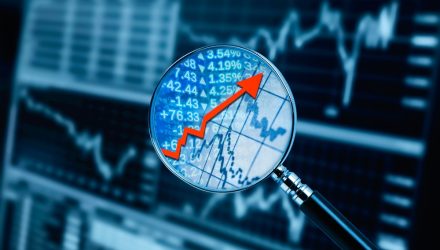Despite the ongoing uncertainty, equity declines have been orderly with no real extreme market moves as reflected by the CBOE Volatility Index and VIX-related exchange traded funds.
Year-to-date, the iPath Series B S&P 500 VIX Short Term Futures ETN (VXX) increased 20.9% and the ProShares VIX Short-Term Futures ETF (VIXY) advanced 14.1%. Meanwhile, the CBOE Volatility Index is now hovering around the 26.3 level.
According to analysts at BofA Global Research, the difference in the volatility of the bond and stock markets is at the widest differential since at least 2000, the Wall Street Journal reported. The analysts warned that the gap is unsustainable and argued the stock market is underestimating the risk of a recession.
Others, though, believed that the equity market’s traditional gauge for volatility might be masking underlying concerns as many have already stepped away from the markets with overweight cash positions.
“There are two scenarios which could play out,” Matthew Tuttle, managing director at AXS Investments, told the WSJ. “Either the Fed loses control of inflation and is forced to raise rates like crazy, or they cut rates because they induced a recession. Neither scenario looks good for equities.”
Despite the ongoing uncertainty, the stock market’s so-called fear gauge has not flashed any extreme warning signals. The Cboe Volatility Index, or VIX, is only hovering at slightly elevated levels. It hasn’t closed above 30, a key level that signifies heightened market fear, in over three weeks. Additionally, the VVIX, an index measuring the volatility of the VIX itself, has dipped relatively steadily since January, reflecting the lessening extreme whips in market volatility.
“One of the reasons the VIX is not more elevated is because it is a hedging tool,” Andrew Slimmon, managing director and senior portfolio manager on long equity strategies at Morgan Stanley Investment Management, told the WSJ. “There are so many investors so heavy in cash, they haven’t needed to use options to hedge. I don’t think the VIX is telling the story of the magnitude of volatility.”
Looking ahead, some market observers cautioned that the corporate earnings season could trigger more wild oscillations as investors look to see which companies have been able to pass on the higher costs to customers.
“Volatility is in wait and see mode until we get greater clarity on earnings and company guidance,” Terry Sandven, chief equity strategist at U.S. Bank Wealth Management, told the WSJ.
For more news, information, and strategy, visit VettaFi.
